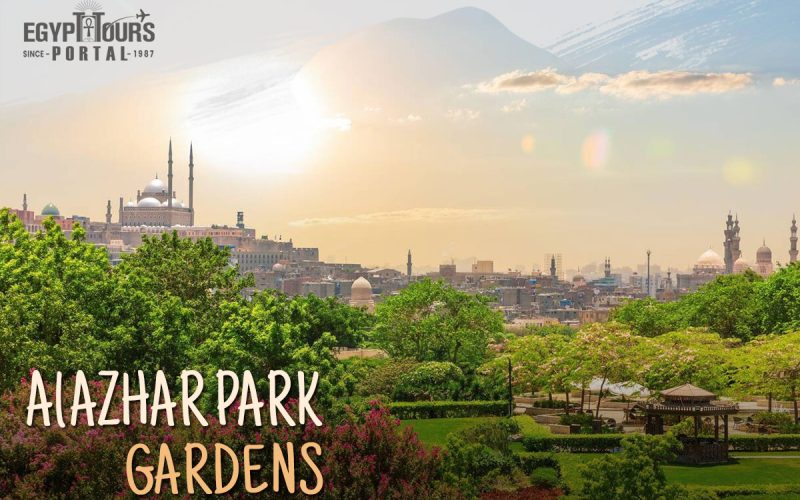Introduction
Cairo is often celebrated for its bustling streets, historic mosques, and world-renowned monuments. Yet hidden within the city’s fabric lies a rare urban oasis—Al Azhar Park in Cairo. Stretching across 30 hectares of landscaped greenery, this park offers more than just a breath of fresh air. It is a cultural, historical, and environmental landmark that redefines how locals and visitors alike experience the Egyptian capital.
Al Azhar Park in Cairo: Beauty Beyond the Walls

1. The History Behind Al Azhar Park
The story of Al Azhar Park begins not as a lush garden, but as a neglected landfill. For centuries, the area adjacent to Cairo’s historic Islamic district had been a dumping ground. In the 1990s, the Aga Khan Trust for Culture initiated a remarkable transformation, turning a space of urban decay into one of the most celebrated public parks in the Middle East.
The project not only reclaimed the land but also unearthed forgotten treasures. During excavation, the long-buried Ayyubid Wall, dating back to the 12th century, was rediscovered and later restored. Today, the park is as much a historical site as it is a leisure space, linking Cairo’s modern identity with its medieval heritage.
2. Design and Landscape: A Blend of Tradition and Modernity
Al Azhar Park in Cairo is a showcase of thoughtful design, balancing environmental renewal with cultural symbolism. Its gardens reflect traditional Islamic landscaping principles, characterized by symmetry, geometric patterns, and water features that symbolize life and purification.
The park is divided into distinct zones, including terraced gardens, tree-lined promenades, and open lawns. Fountains and artificial lakes add to the tranquility, while carefully placed pathways invite leisurely walks and quiet reflection. Native plants such as palm trees, olive groves, and bougainvillea ensure the park remains vibrant in Cairo’s climate.
3. Cultural Significance and Surrounding Heritage
What makes Al Azhar Park unique is its proximity to Cairo’s historic core. From its elevated vantage points, visitors enjoy sweeping views of landmarks like the Citadel of Saladin, the Mosque of Muhammad Ali, and countless minarets dotting the skyline.
The park also functions as a cultural bridge. Its creation revitalized surrounding neighborhoods, encouraged heritage preservation, and brought international attention to Cairo’s Islamic architecture. Restoration projects funded alongside the park included mosques, houses, and parts of the old city wall, ensuring that the park’s impact extended well beyond its boundaries.
4. Things to See and Do in Al Azhar Park
Whether you’re a history enthusiast, a leisure seeker, or a photographer, the park has something to offer.
- Panoramic Views: From the highest points, visitors can see Old Cairo stretching to the pyramids on a clear day.
- Dining with a View: Restaurants and cafés inside the park provide opportunities to savor local and international cuisine while overlooking historic Cairo.
- Walking Paths and Gardens: The park’s trails are ideal for strolls, family outings, or quiet reading under shaded trees.
- Historic Structures: Sections of the Ayyubid Wall and restored gates are accessible, blending recreation with education.
- Cultural Events: Al Azhar Park frequently hosts concerts, festivals, and exhibitions, bringing modern life into harmony with historical surroundings.
5. Environmental Impact and Urban Renewal
Beyond aesthetics, the park has a lasting environmental influence. By reclaiming a neglected landfill, it improved air quality, provided green space for millions, and established a model for sustainable urban development in the region.
Water recycling systems, native plant use, and careful landscape management highlight how Al Azhar Park balances beauty with ecological responsibility. For Cairo, a city with limited public parks, it serves as a vital green lung and a successful example of environmental regeneration.
6. Visitor Experience: Practical Information
For those planning to explore Al Azhar Park in Cairo, here are some helpful details:
- Location: Situated near the historic district of Islamic Cairo, with easy access by taxi or car.
- Opening Hours: Typically open daily from morning until late evening.
- Entry Fees: A modest entrance fee helps maintain the park and supports ongoing preservation projects.
- Best Time to Visit: Late afternoon offers cooler temperatures and breathtaking sunset views over the city skyline.
The park’s family-friendly environment makes it an ideal destination for both locals seeking respite from city life and travelers eager to discover Cairo beyond its well-known monuments.
7. Why Al Azhar Park Matters
Al Azhar Park in Cairo is more than just a leisure destination—it is a statement about reclaiming urban space, celebrating heritage, and integrating nature into one of the world’s most densely populated cities. Its beauty lies not only in its gardens but in its role as a symbol of renewal and cultural continuity.
Conclusion: Beauty Beyond the Walls
Al Azhar Park stands as proof that neglected spaces can be transformed into thriving community assets. With its lush landscapes, sweeping city views, and deep historical connections, it offers a rare perspective on Cairo—one that is peaceful, inspiring, and enduring.
For visitors asking where to experience Cairo’s past and present in harmony, the answer lies within the walls of this remarkable park.












